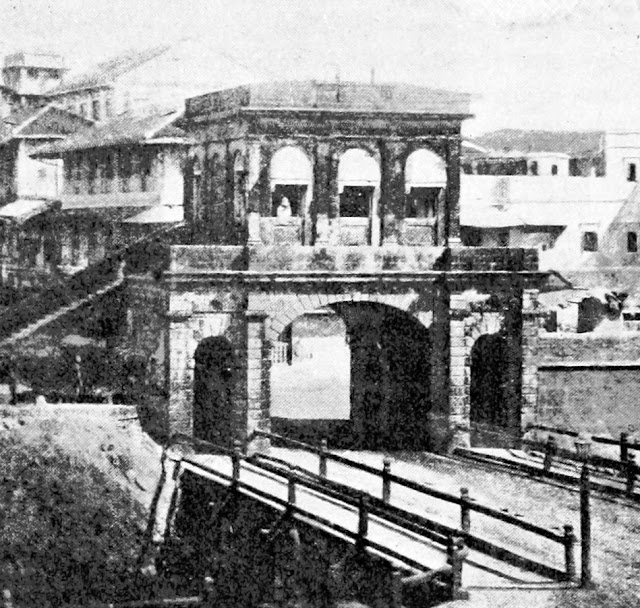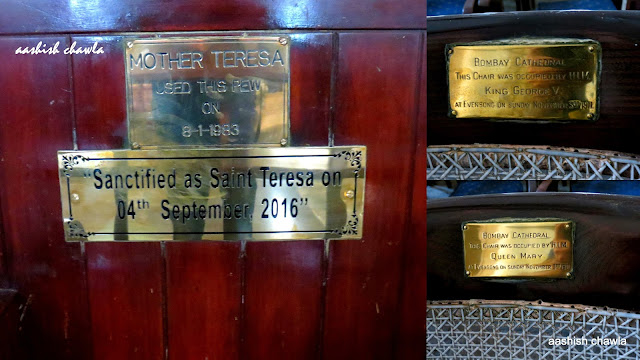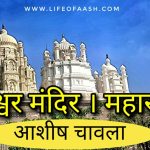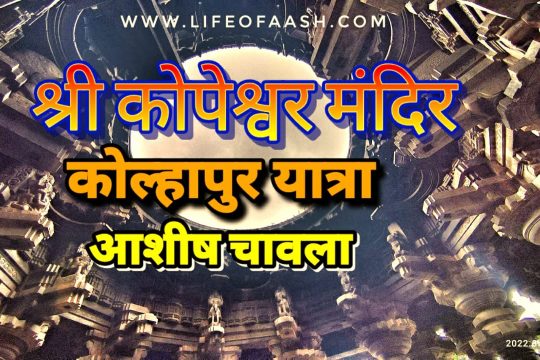It all started when last month I came across an article in the MIDDAY newspaper. A three hundred years old church was celebrating its tri-centenary. Naturally I was all inquisitive to know where was this church, what was the history behind and as I started my research I was getting more and more immersed into the past of this church. What got unveiled left me dumbfounded!.
| Present Churchgate Station |
For all these years passed, I never knew why Churchgate Station was called Churchgate and over that we always enjoyed Kishore Kumar crooning in the movie DON, Ee hai bumbai nagariya tu dekh babuwa….jaha churchgate ka church hai lapata.
Well the good news is I found the missing Church.
Jokes apart, St Thomas cathedral is in fact that missing church which gives Churchgate its name and another interesting fact about this church is that it is Point Zero spot where the pin falls in “Bombay”from where distance in the city was measured in milestones.
History:
St Thomas Cathedral stands testimony to the colonial past. The times when there was actually a fortified British settlement of Bombay which we call as Fort area in present times except that today there is no fort, no bastions or fort walls. What we see today is bustling commercial hubs yet being a commercial hub the British era can still be felt,looking around the buildings in these areas which are converted to Govt offices or bank premises.
Till the 19th century the Bombay was fortified settlement with a fort wall and a moat.
The city had three gates
Apollo Gate- at Apollo Bunder
Bazaar Gate- That is where today Chhatrapati Shivaji Bus Terminus
Churchgate- Where the Flora fountain stands today.
 |
| Old Church gate,where the present day Flora Fountain stands (Pic source Wikipedia) |
All the gates along with the city wall was demolished in the year 1860.
As the city of Bombay was inhabited by the Britisher they needed a place to worship so in the year 1676 the foundation stone was laid by the Governor Gerald Aungier the same year that Emperor Aurangzeb began building Badshahi Masjid or mosque in Lahore. Unfortunately after the death Gerald Aungier the construction of the church was abandoned,however as the construction of the church was underway so the structure stood half way at 5 metres high for half a century. In 1710 Richard Cobbe the Chaplain adopted this unfinished Church and got the construction completed and finally the church was thrown open to the general public on the Christmas day 1718.
The Church was named after St. Thomas, the Apostle, one of the 12 Disciples of Lord Christ who is believed to have come to India.
In the year 1837, the Church was consecrated as a Cathedral and Rev. Thomas Carr was appointed the first Bishop of Bombay. The Church underwent lots of additions and renovation and took its present form in the year 1865.
In the 18th and 19th century the Cathedral was divided on the basis of different classes of society.There were even separate rooms for “Inferior Women” ( Now don’t ask me what does that mean, I always felt that all humans are equal in the eyes of God, yet why this discrimination…probably another creativity of humans to divide the humans )
My Journey :
Armed with all the info that I can gather I was very eager to have a first hand experience of seeing the St Thomas Cathedral. So Weekend wanderer that I am, I set out one Sunday afternoon to visit this church. Let me share my experience from here on.
I took local train from Andheri to Churchagate and it was 4 pm when I reached the Churchgate station. Coming out of the station I started to walk towards Hutatma Chowk aka Flora Fountain and from there towards Horniman circle, just before that you see a Clock tower like structure and you can be forgiven if you mistook it for a clock tower. Its not a clock tower but the church, St Thomas Cathedral. I have come to Horniman circle for upteem times I fact I must have savoured the coffee at Starbucks just opposite to it and yet missed this so important monument.
As I was entering the church I noticed a beautiful ornate fountain in front of the main entrance.
In 1864, Sir Cowasji Jehangir Readymoney, a Parsi philanthropist, had gifted this Gothic fountain to this church, because he wished to donate one in the vicinity of his residence, still known as Readymoney Mansion.
| ReadyMoney Mansion (It still exists) |
This kind of donation was nothing unusual gesture for Sir Cowasji Jehangir Readymoney, because he had donated 40 iron fountains to Mumbai, of which only six can be found now. This ornate fountain actually compliments to the beauty of this Cathedral.
| Made for each other |
This fountain was brought from London in parts.”The local Parsi community were unhappy that such generosity was wasted on ‘Unbelievers’ and hence they disparagingly nicknamed the fountain the ‘Cowasjee Cross’.”( Source Times of India Report)
| Lobby at the entrance of the church |
From here I moved to enter the Church. As we enter the Church we find a small lobby, what is noticeable here is the designed flooring, a designed wrought iron gate and the visitor book lying on the right side of the lobby.
| Designed flooring in the lobby |
Next we enter the main hall, What I saw was very imposing and grand.The inside of the church is painted in white.There was these beautifully designed huge wrought iron brackets which holds the fans in the church.
| Wrought Iron fan brackets in the hall catches your eyes |
The next thing that interested me a lot was the many memorials made of marble stone that adorned walls of the church. These memorials tell different stories of the different people and look very ostentatious.
| Memorial for 300 Passengers who perished on steamship Cleopatra |
The first Memorial that I saw was for the 300 passengers of the Steamship called Cleopatra, who perished when the ship sank of the coast of Malabar on 15th April 1847. the ship was en-route from Bombay to Singapore.The monument was erected by the officers and the seaman of Indian navy as per the plaque
The next interesting memorial was this huge memorial for Jonathan Duncan.
| Memorial of Jonathan Duncan |
Jonathan Duncan was the longest serving governor (16 years)The memorial comprises of a Dhoti clad Brahmin and a statue depicting the symbol of justice and this was all set against the backdrop of Banyan Tree with the smiling Chirubs.
In the words of Reverend Avinash Rangayy the Church Priest “Duncan was a visionary who abolished infanticide in India… those cherubs denote this good deed. He was an Indophile — the Brahmin and the banyan tree depict his deep association with India, while the statue portrays his fairness in judgement despite being a colonial ruler.”
| Memorial for Captain George Nicholas Hardinge |
Another interesting and beautifully carved monument of horses with a fairy and waves caught my eye. On closer observation I noted it was a memorial to Captain George Nicholas Hardinge
As per the plaque Captain George commanded the ship called “San Fiorenzo” considered to be terror of Indian seas which had 36 guns and 186 men on it.
He chased and fought for three successive day the enemy frigate “La-Piedmantaise which had 50 guns and 566 men on it. Yet The Captain along with his crew achieved a brilliant conquest but unfortunately fell in the last and critical, part of this heric battle. It is said that he was very much inspired by his hero Lord Nelson. Captain George dies in the year 1808.
last but not the least i liked this peculiar kind of memorial which looked like a coffin with a statue of a priest lying on it. This memorial belonged to the Rev. Thomas Carr The first bishop of Bombay.
| Memorial of First Bishop of Bombay |
Other than this there are many more exotic memorial some of which are in brass form each telling a different tale. Do visit and read each epitaph probably you may find some new secret unveiled.
After going through all the memorials I came down to the central of the church and started to walk down the nave. Just as I was to about to approach near the chancel,on my right side on the first row of the seating chairs I saw these two iconic chairs . Iconic because these chairs were occupied by King George and the queen on 3rd Nov, 1911.
 |
| Copper plate on the seats |
Just before that there is this pew on which was used by Mother Theresa on 08.01.1989. I get goosebumps when I find myself so near the history and could actually feel the presence of this blessed soul.
After this I move towards the altar area or rather the chancel, what catches your eyes is the lovely stained glass windows with colour paintings of St Thomas and many others.
| Some beautiful designed stained glass windows |
| The chancel |
One of the paintings at the cathedral shows St Thomas with a Bible in his hand and a T square in the other hand perhaps reminding the viewers that at on time he was a builder by profession standing next to him on both his sides are archangels St Gabriel holding a lily symbolising purity and truth. and St Micheal holding a double edged sword, symbolising truth and justice.
No wonder that such beautiful Church is considered as a heritage site and is a recipient of UNESCO Asia-Pacific Heritage Conservation Award.
| Stained glass window of St Thomas,St Gabriel and St Michael |
I was simply overwhelmed by what I experienced here. I sat for sometime soaking in all the grandeur and the peace the place had to offer. Paid my respect to the lord and came out of the Cathedral as a contented man.
 |
| Thank You |





